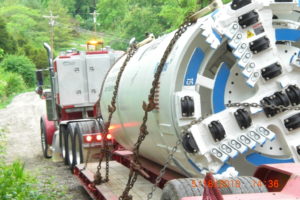![65 Years of Innovation and Experience [default]](https://www.robbinstbm.com/wp-content/uploads/2017/04/Side-Bar-Blue-Blocks_70-Years.jpg)
A Solution for Every Condition: Search our Project Database
Project Map
FEATURED PRODUCT: CROSSOVER MACHINES
Our History
A Legacy of Innovation
Information 24/7
News & Media
Insights in the Industry:
Read the Robbins Blog
 Seven new sewer tunnels were recently completed in Ohio’s Clermont County, replacing an outdated and exposed system that was dumping raw sewage into local Shayler Creek. Since 1978, when the previous pipeline was installed, the creek had eroded, exposing the pipe and putting certain sections of the line at high risk of failure. For all of these reasons, a new pipeline needed to be installed far below the environmentally-sensitive waterway.
Seven new sewer tunnels were recently completed in Ohio’s Clermont County, replacing an outdated and exposed system that was dumping raw sewage into local Shayler Creek. Since 1978, when the previous pipeline was installed, the creek had eroded, exposing the pipe and putting certain sections of the line at high risk of failure. For all of these reasons, a new pipeline needed to be installed far below the environmentally-sensitive waterway.
The Clermont County Water Resources Department hired Indianapolis contractor Midwest Mole for the $15M USD project, and chose to use only one machine for the seven tunnels. A 1.8 m (72 in) diameter Robbins Double Shield Rockhead was used to excavate all of the tunnels, totaling 2,900 m (9,513 ft). The contractor’s unique approach also included eliminating three shafts from the original bid, which shortened the project schedule and significantly lowered costs.
Because of the project location below the creek bed, ground conditions were highly varied, consisting of interbedded layers of limestone and shale that ranged from dry to sticky and wet. To accommodate the mixed ground, the machine was outfitted with a mixed ground cutterhead that could be swapped out for a hard rock cutterhead based on the ground conditions at each crossing.
The mixed ground cutterhead featured 6.5 in single disc cutters and carbide bits, while the hard rock cutterhead contained 11.5 in single cutters and abrasion-resistant muck scrapers. Both cutterheads had large openings which allowed for efficient cutter changes.
The Robbins Double Shield Rockhead (SBU-RHDS) is a tunneling machine typically used on utility installations of over 150 m (500 ft). Its continuous steering capabilities and laser targeting system make it the ideal solution for line-and-grade critical installations such as the Shayler Run Segment C Sewer Replacement Project.
The SBU-RHDS is available in diameters from 1.4 to 2.0 m (54 to 78 in), and consists of a cutterhead optimized for mixed and hard rock ground conditions. The machine’s circular cutterhead contains disc cutters capable of excavating ground ranging from 25 to 175 MPa (4,000 to over 25,000 psi) UCS.
As the cutterhead rotates, the cutters penetrate the rock face creating “crush zones” through which fractures propagate. Material between adjacent crush zones is then chipped from the face. Muck scrapers scoop the muck into muck buckets, which transfer the muck onto a machine belt conveyor. Muck is transported offsite via conveyor belt or muck cars.
 A total of seven tunnel crossings connected by eight shafts were constructed by Midwest Mole. The tunnels utilized the Rockhead, while the shafts were constructed using a combination of drill and blast techniques and manual excavation. A primary liner of ring beams and lagging was installed every 1.5 m (5 ft) at each crossing. Even with liner installation, high production rates of 12 to 18 m (40 to 60 ft) per 12-hour shift were maintained for the project duration.
A total of seven tunnel crossings connected by eight shafts were constructed by Midwest Mole. The tunnels utilized the Rockhead, while the shafts were constructed using a combination of drill and blast techniques and manual excavation. A primary liner of ring beams and lagging was installed every 1.5 m (5 ft) at each crossing. Even with liner installation, high production rates of 12 to 18 m (40 to 60 ft) per 12-hour shift were maintained for the project duration.
Due to the gravity sewer construction, each tunnel had strict line-and-grade requirements of within 300mm (1 ft) of line at 1 to 2% grade, which was continuously monitored from an in-shield operator’s console. Over the course of the project, the variance resulted in a vertical change of 53.9 m (177 ft) causing the machine to bore through a wide range of ground conditions.
Excavation of the initial 484.3 m (1,589 ft) crossing began in May 2010 in mixed ground, and the Rockhead broke through to its first shaft site that August. After a few minor modifications to the hydraulic and muck haulage systems, the machine began boring the second 575.4 m (1,888 ft) crossing.
Crossings 3 and 4, 321.9 m (1,056 ft) and 304.8 m (1,000 ft), respectively, were excavated in December 2010 and January 2011 in adverse winter weather conditions. In order to keep tunneling during freezing temperatures, the contractor heated the machine’s cooling water overnight. Cooling water was recycled and filtered, then stored in 7, 500 l (2,000 gal) tanks with heaters. Using this technique, production rates stayed high and both crossings were successfully excavated by January 2011.
The Rockhead began its fifth and longest crossing of 613.8 m (2,014 ft) in April 2011, and reached a world record in tunneling distance for a hard rock machine of its 1.8 m (72 in) diameter. For the last two crossings, 402.3 m (1,320 ft) and 196.9 m (646 ft), respectively, the mixed ground cutterhead was replaced with its hard rock counterpart.
Due to negotiations with local landowners and a change in shaft location, the final crossing began in January 2012. A month later, the drive was completed. In July 2012, the entire project reached completion right on schedule, with all manholes and ancillary sewers tied in and in service.

 Close
Close